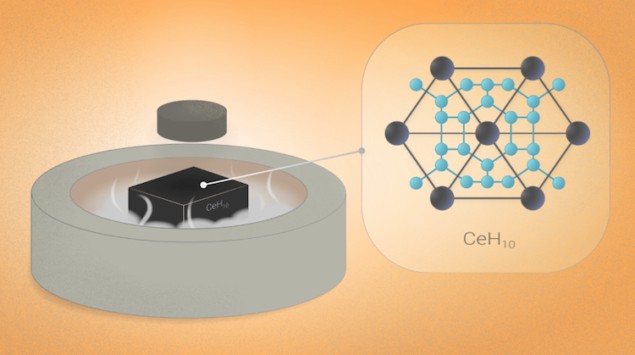
Researchers in China and Russia have discovered superconductivity in two new phases of a hydride material at pressures much lower than those needed to stabilize other recently-discovered hydride superconductors. The work will aid the search for lower-pressure and potentially room-temperature superconductors.
Superconductors are materials that conduct electricity without any resistance. Many materials display superconductivity when they are cooled to low temperatures, and the phenomenon was first observed in 1911 in solid mercury, which has a superconducting transition temperature Tc of 4.2 K. The search for superconductors that operate at warmer temperatures – perhaps even room temperature – has been on ever since. A material that remains superconducting at ambient temperatures would hugely increase the efficiency of electrical generators and transmission lines, as well as simplifying existing applications such as superconducting magnets in particle accelerators and MRI scanners.
Step closer to holy grail
Physicists came a step closer to this holy grail in the 1980s and 1990s with the discovery of high-temperature superconducting copper oxides, which have Tcs between 30–133 K. It wasn’t until 2015, however, that the maximum critical temperature took a major leap forward with the discovery that hydrogen sulphide has a Tc of 203 K when compressed to pressures of 150 GPa.
While materials that only superconduct at such extreme pressures have few (if any) practical applications, studying them may offer a path to discovering new compounds that superconduct at milder temperatures and pressures. For this reason, the hydrogen sulphide result sparked a flurry of interest in solid materials containing hydrogen atoms bonded to other elements. Since then, several other hydrogen-rich superconductors have been made in the laboratory. In 2019, researchers reported breaking hydrogen sulphide’s record with lanthanum decahydride (LaH10), which they found to have a Tc of 250–260 K. And in 2020, another group reported observing a Tc of 288 K in the C-S-H system at around 275 GPa.
Superconductivity in cerium hydrides
The team, led by Tian Cui, Xiaoli Huang and Wuhao Chen from Jilin University in China together with Artem Oganov and Dmitrii Semenok of Russia’s Skolkovo Institute of Science and Technology (Skoltech), took a slightly different approach. In 2019, members of the team synthesized a new cerium hydride with the formula P63/mmc-CeH9. Each cerium atom in this material is enclosed in a H29 cage in the atomic hydrogen sublattice, and it had previously only been studied theoretically. This same team has now found superconductivity in novel phases of both CeH9 and another newly-synthesized material, CeH10.
The researchers note that cerium hydrides are remarkable materials, as they are stable and display high-temperature superconductivity at lower pressures (about 0.8 million atmospheres) than other so-called “superhydrides”. As such, they say that these compounds “serve as an ideal starting point to further study the mechanism of superconductivity in these fascinating compounds, and design other superconductors, stable at even lower pressures”.

On the road to room-temperature superconductivity
In their previous work, the Skoltech-Jilin researchers found a close relationship between the location of elements within the periodic table and the superconductivity of hydrides made from these compounds. They now believe that this relationship may also apply to materials other than hydrides. “Take La and Ce, for example – they are neighbours in the periodic table and indeed both form high-temperature superconductors,” Oganov explains. “However, there are differences: LaH10 superconducts at higher temperatures, while CeH10 is stable at lower pressures.”
Now that the binary hydrides have been well-studied, the Skoltech-Jilin team says that it will focus on achieving higher-temperature superconductivity at lower pressures in ternary hydrides. “We know which elements lead to higher-temperature superconductivity and have begun to learn which ones lead to stability at lower pressures,” Semenok says. “These are the main notes, but it takes imagination to combine them into a melody.”
The present work is detailed in Physical Review Letters.



